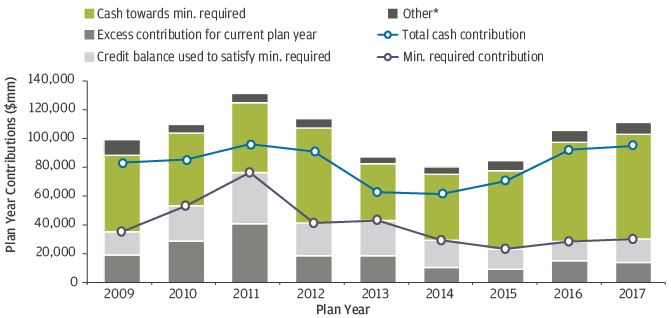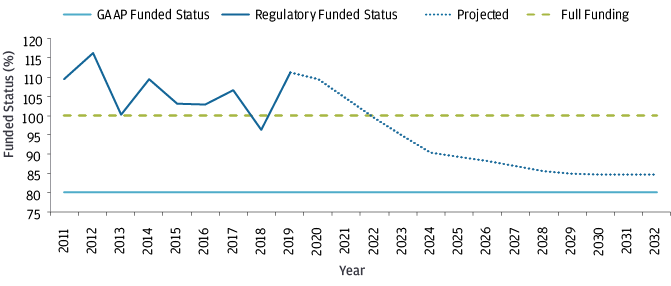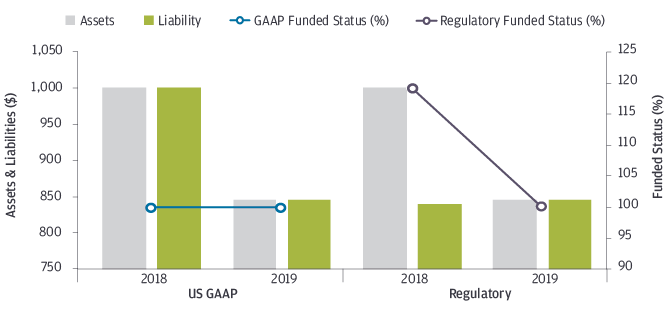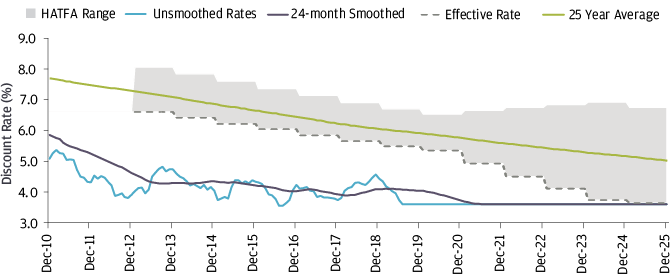Pension indigestion: considerations for the end of regulatory relief
The evolution of pension regulations and implications for asset allocation
2019-12-09
Michael Buchenholz
Most of us who grew up before the age of netflix and commercial- free streaming will remember the legendary slogan for the popular indigestion remedy:
“How do you spell relief? R-O-L-A-I-D-S”
For pension plan sponsors, relief has been spelled many different ways since the implementation of PPA in 2009, reflecting the leitmotif of higher statutory discount rates, leading to lower liability valuations and reduced or eliminated contribution requirements. A synopsis of previous legislation impacting contribution requirements and incentives is outlined below:
| Legislation / Regulation | Description | Year of Impact |
|---|---|---|
| Pre-PPA | IRS valuations performed using an average of 30-year U.S. Treasury yields |
n/a |
| Pension Protection Act (PPA) | High quality corporate bond discount rates, fund to 100% over 7-year period | Effective for plan years beginning in 2008 |
| 2008 Worker, Retiree, and Employer Recovery Act (WRERA) | Permitted transitional relief for plans falling below phase-in funding targets and incorporation of expected return into smoothed asset values |
Effective for 2009 plan years |
| PPA Discount Rate Relief | Guidance allowed use of October, 2008 yield curve instead of much lower January, 2009 yield curve | Effective for 2009 plan years |
| Pension Relief Act of 2010 (PRA) | Election of “2 and 7” or “15-year rule” providing relief on shortfall amortizations | Effective for plan years beginning in 2008, ending with plan years beginning in 2011 |
| Moving Ahead for Progress in the 21st Century Act (MAP-21) |
Introduction of 25-year average and corridor |
Effective for plan years beginning 2012 or later |
| Highway and Transportation Funding Act of 2014 (HATFA) |
Extended corridors of MAP-21, increased PBGC premiums | Effective for plan years beginning in 2013 |
| Bipartisan Budget Act of 2013 (BBA-2013) |
Further increases in PBGC premiums |
Effective for plan years beginning in 2015 |
| Bipartisan Budget Act of 2015 (BBA-2015) |
Further extension of MAP-21 corridor, further increases in PBGC premiums | Effective for plan years beginning in 2017 |
| Tax Cuts and Jobs Act of 2017 (TCJA) |
Reduced corporate tax rate from 35% to 21%, incentivizing accelerated sponsor contributions |
Effective for plan years beginning in 2018 |
Source: J.P. Morgan Asset Management, IRS.
Now Rolaids really can spell “relief” when used appropriately. But if the relief provided simply gives the patient enough respite to scarf down another pepperoni pizza, they might actually be worse off in the end when the medication wears away. This parallels with the pension relief provided to corporate pensions from the range of legislative acts outlined above. Importantly, we are reaching a point where the impact of these acts is expected to effectively disappear over the next couple years, against the backdrop of U.S. generally accepted accounting principles (GAAP) discount rates bumping up against their post-crisis lows. Plan sponsors who simply took a long contribution holiday may be shocked into a proverbial food coma as regulatory discount rates normalize. On the other hand, plan sponsors who prudently used pension relief to move out the surplus risk curve, increasing returns to close funding gaps while opportunistically making discretionary contributions, likely find themselves much farther down their respective glidepaths and relatively unaffected by the impending moderation in regulatory discount rates.
Finally, after multiple rounds and years of pension relief, required contributions are making their way back onto plan sponsors’ radars. The corridors around 25-year average rates, within which the discount rates used for contribution requirements must fall, are slated to widen for the first time from 90%–110% to 85%–115% for plan years beginning in 2021.
EXHIBIT 1: DECOMPOSITION OF PLAN YEAR CONTRIBUTIONS

Source: J.P. Morgan Asset Management, Department of Labor 5500 Filings. As of 9/30/2019
*Other includes contributions to avoid benefit restrictions, contributions allocated to prior years and the impact of discounting plan year contributions back to the valuation date. Data reflects all plans with more than 500 participants.
Pension regulatory relief review
The most relevant form of pension relief today stems from MAP-21 and its extension, through its direct descendants, HATFA and BBA-2013. The essence of the relief is to authorize higher discount rates, thus reducing regulatory liability valuations, increasing funded status levels and reducing contribution requirements, all else equal. Understanding the mechanisms that give rise to these higher discount rates is essential to understanding their unwind and resulting implications (see EXHIBIT 4 for a visualization of these dynamics):
1) 25-year Average of Rates: Based on high-quality A or better corporate bond yields, the 25-year average of rates will fall as time passes with a high degree of visibility and certainty. In the mid-90s, high-quality long duration yields were in the 8s and GAAP discount rates are currently in the 3s at the time of publication. At this point, a signifi t spike in rates would only temper the inevitably downward moving average.
2) Rate Corridor: The corridor is the range around the 25-year average that discount rates are permitted to fall. The lower bound (90% of the average) has been the binding constraint since the introduction of pension relief but will begin to widen in 2021, ratcheting down until settling at 70% in 2024 and beyond.
Looking back at the past decade of contributions, we can detect the effect of relief on funding. The fi st effective plan year for MAP-21, 2012, coin- cides with a sharp drop off and break in the contribution trend line (see EXHIBIT 1). While required contributions continued to decline, actual cash contributions from sponsors picked up around 2015, corresponding with the increased PBGC premiums under BBA-2013 and refl ting discretionary contributions to mitigate these costs. Each year about 20% of the total discretionary contributions come from the 10 largest plans (for example, in 2017, General Electric contributed $6.8bn against a required contribution of $1.3bn, after using credit balance to off a portion), but the developments are clear. Legislation has weakened contribution requirements. Some plan sponsors have stayed the course and exceeded requirements, while others have used the opportunity to take a contribution holiday. As we look in the future, that may no longer be an option. As pension relief unwinds, there are several implications for plan sponsors and pension risk management.
Source: GE Pension Plan 2017 DOL 5500 Filing
How have plan sponsors reacted to the legislative regulatory changes and what might the implications be for future asset allocation decisions?
Pension implications going forward
In EXHIBIT 2, we illustrate what regulatory funded status a plan with an 80% GAAP funded status might experience at different points in time. The spread between the two measures was as high as 35% in 2012 but has and is projected to continue declining. The two measures eventually converge around 2027, with regulatory funded status a couple percentage points higher than GAAP due to an A or better versus AA discount rate. Generally, there are two key thresholds for regulatory funded status that plan sponsors need to consider:
1) Below 100%: As a practical simplification, below this threshold deficit contributions will be required.
EXHIBIT 2: ESTIMATED REGULATORY FUNDED STATUS FOR A PLAN CONSISTENTLY FUNDED 80% ON A U.S. GAAP BASIS
 Source: J.P. Morgan Asset Management, FTSE Pension Discount Curve, IRS. As of 9/30/2019.
Source: J.P. Morgan Asset Management, FTSE Pension Discount Curve, IRS. As of 9/30/2019.
Regulatory discount rates are projected by assuming that unsmoothed spot rates remain unchanged from the latest available levels as of July 2019 (2.34%, 3.38% and 4.01% for 1st, 2nd and 3rd segment rates, respectively). Analysis uses constant mortality assumptions across time and for each funded status measure.
2) Below 80%: Benefit restrictions on lump sum payments and certain plan amendments kick in. Importantly, this key 80% threshold applies to regulatory funded status, not GAAP, although as we alluded to earlier, the difference will taper over the coming years.
With these key levels in mind, plan sponsors with a restricted contribution budget may find their tolerance for funded status volatility diminished, all else equal. As the buffer between GAAP and regulatory values fades, drops in funded status will more easily translate into contribution requirements or restrictions on lump sum offerings, a popular tool for liability management. The changing environment also gradually removes a potential impediment to de-risking, which threatened to jeopardize the legislative reprieve. To illustrate this effect, let’s examine a stylistic example outlined in EXHIBIT 3:
A plan is 100% funded on a U.S. GAAP basis and fully hedges all interest rate risk. Over the year, interest rates rise 150 basis points, driving GAAP pension liabilities as well as plan assets down by 15%, but nonetheless leaving the plan fully funded. On a regulatory basis, the plan was almost 120% funded at the beginning of the year. However, despite the rise in market interest rates, the regulatory liabilities actually increase while assets decrease by 15%. In this example, the plan sponsor has completely eroded its pension relief contribution buffer by taking the seemingly prudent action of closing the duration mismatch.
We see a similar effect in EXHIBIT 2 during 2013, where the relief funded status buffer is eroded by a significant increase in market discount rates. As the relief fades away, so should concerns related to this counterintuitive effect.
EXHIBIT 3: IMPACT OF 150BPS RISE IN DISCOUNT RATES ON GAAP VERSUS REGULATORY FUNDED STATUS FOR A PLAN THAT FULLY HEDGED ALL INTEREST RATE EXPOSURE.
 Source: J.P. Morgan Asset Management. As of 9/30/2019.
Source: J.P. Morgan Asset Management. As of 9/30/2019.
EXHIBIT 4: REGULATORY DISCOUNT RATES PROJECTION FROM JULY 2019

Source: J.P. Morgan Asset Management. As of 9/30/2019.
The more striking implication is that the option to wait and “grow your way out” of a pension deficit, absorbing any funded status drops along the way, may be removed from the table. If sponsors can’t achieve full funding in a timely fashion through returns alone, contributions will need to fill the gaps. Ultimately, this means sponsors following a glidepath may find themselves de-risking into a low rate environment, rather than into a set of favorable market circumstances that traditionally would drive funded status higher (for example, selling equities into a bull market or buying bonds after a sell-off in rates). In order to navigate this altered backdrop for pension risk management, we think plans will need to put more of an emphasis on balancing returns and surplus volatility while identifying how funded status shocks can transmit into required contribution outlays. Traditional methods for taking down risk, selling equities and buying long duration credit, in the current environment present a number of challenges with record low interest rates and late-cycle credit dynamics. Against this backdrop, we think that long duration substitutes (securitized credit and mortgages) and complements (infrastructure and other income- oriented alternatives) should play a key role in portfolios as sponsors react to the changing regulatory environment.
Conclusion
While we expect regulatory conditions to tighten with the wear-away of pension relief, there is still smoothing available to absorb market shocks. Discount rates can still be smoothed over 24 months, as can asset values. However, navigating the waters of pension risk will be markedly different than it has been compared to the preceding decade. Funded status shocks will more readily translate into required contributions or benefit restrictions, and sponsors will be obligated to make progress toward full funding. On the other hand, if history is any guide, at the next sign of trouble new legislation will delay the originally intended funding regulations for another decade or so. If not, plan sponsors who are unprepared may find themselves looking for relief.
Glossary of terms
Guide to regulatory discount rates:
- Segment Rates: yield curve constructed with 3 different rates across the curve: Segment 1 (0-5 years), Segment 2 (5-20 years), Segment 3 (20+ years)
- Unsmoothed Rates: segment rates based on A or better corporate bond yields averaged across each trading day of the month; also used for 417(e) Minimum Present Value calculations for lump sums
- 24-month Smoothed Rates: segment rates that average unsmoothed rates at each maturity over the previous 24 months
- 25-year Average Rates: 25-year average of 24-month Smoothed Rates across each maturity
- HATFA Range: corridor around 25-year Average Rates reflecting the latest BBA-2015 legislation (the corridor starts to widen in the 2021 plan year)
- Effective Rates: the effective rate is used for regulatory valuations and is equal to the maximum of the HATFA Range lower bound and the 24-month Smoothed Rates
0903c02a8271dec5